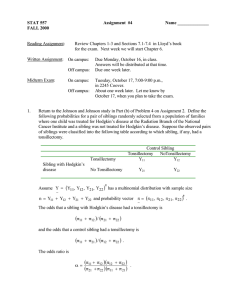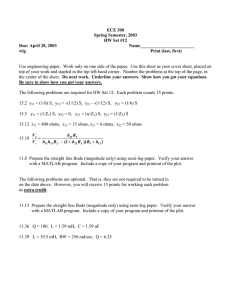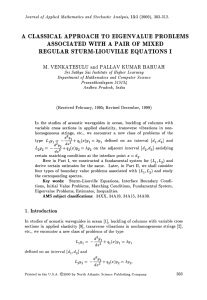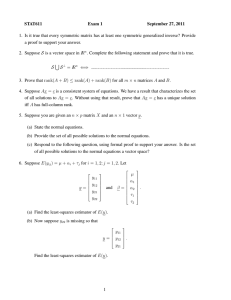Lecture 4: Two-Port Circuits and Power Gain - RFIC
advertisement
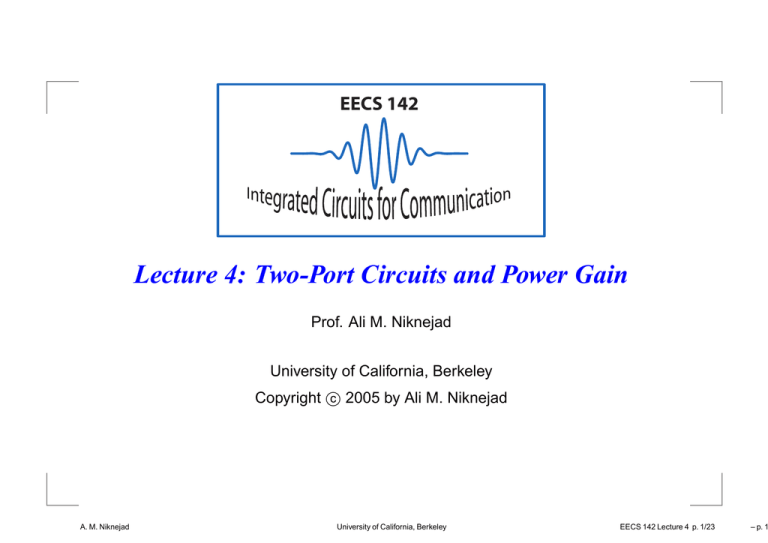
EECS 142 Lecture 4: Two-Port Circuits and Power Gain Prof. Ali M. Niknejad University of California, Berkeley c 2005 by Ali M. Niknejad Copyright A. M. Niknejad University of California, Berkeley EECS 142 Lecture 4 p. 1/23 – p. 1 A Generic Amplifier YS + vs − · y11 y21 y12 y22 ¸ YL Consider the generic two-port amplifier shown above. Note that any two-port linear and time-invariant circuit can be described in this way. We can use any two-port parameter set, including admittance parameters Y , impedance parameters Z , or hybrid or inverse-hybrid parameters H or G. A. M. Niknejad University of California, Berkeley EECS 142 Lecture 4 p. 2/23 – p. 2 Choosing Two-Port Parameters Feedback Yout YS + vs − Amp YL Yin The choice of parameter set is usually determined by convenience. For instance, if shunt feedback is applied, Y parameters are most convenient, whereas series feedback favors Z parameters. Other combinations of shunt/series can be easily described by H or G. ABCD parameters are useful for cascading two-ports. A. M. Niknejad University of California, Berkeley EECS 142 Lecture 4 p. 3/23 – p. 3 Y Parameters We’ll primarily use the Y parameters ! ! ! i1 y11 y12 v1 = i2 y21 y22 v2 But in fact the choice depends largely on convenience. Often the form of feedback determines the best choice. All 2-port parameters are equivalent. Many of the results that we derive carry in terms of Y-parameters can be applied to other two-port parameters (input impedance, output impedance, gain, etc). A. M. Niknejad University of California, Berkeley EECS 142 Lecture 4 p. 4/23 – p. 4 Admittance Parameters Notice that y11 is the short circuit input admittance i1 y11 = v1 v2 =0 The same can be said of y22 . The forward transconductance is described by y21 i2 y21 = v1 v2 =0 whereas the reverse transconductance is described by y12 . If a two-port amplifier is unilateral, then y12 = 0 A. M. Niknejad University of California, Berkeley EECS 142 Lecture 4 p. 5/23 – p. 5 Hybrid-Π Admittance Parameters Cµ Yπ Rin Cin Yo + vin − Yµ gm vin ro Co Let’s compute the Y parameters for the common hybrid-Π model i2 Yµ y11 = yπ + yµ y21 = gm A. M. Niknejad yµ + v1 − Yπ University of California, Berkeley Yo gm vin + v2 = 0 − EECS 142 Lecture 4 p. 6/23 – p. 6 Admittance Parameters (cont) i1 y22 = yo + yµ y12 = yµ + v1 = 0 − Yµ Yπ Yo gm vin + v2 − Note that the hybrid-π model is unilateral if yµ = sCµ = 0. Therefore it’s unilateral at DC. A good amplifier has a high ratio yy21 because we expect 12 the forward transconductance to dominate the behavior A. M. Niknejad University of California, Berkeley EECS 142 Lecture 4 p. 7/23 – p. 7 Why Use Two-Port Parameters? The parameters are generic and independent of the details of the amplifier → can be a single transistor or a multi-stage amplifier High frequency transistors are more easily described by two-port parameters (due to distributed input gate resistance and induced channel resistance) Feedback amplifiers can often be decomposed into an equivalent two-port unilateral amplifier and a two-port feedback section We can make some very general conclusions about the “optimal” power gain of a two-port, allowing us to define some useful metrics A. M. Niknejad University of California, Berkeley EECS 142 Lecture 4 p. 8/23 – p. 8 Voltage Gain and Input Admittance Since i2 = v2 YL , we can write (y22 + YL )v2 = y21 v1 Which leads to the “internal” two-port gain v2 y21 Av = = v1 y22 + YL Check low freq limit for a hybrid-Π: Av = gm Zo ||ZL X The input admittance is easily calculated from the voltage gain i1 v2 Yin = = y11 + y12 v1 v1 y12 y21 Yin = y11 y22 + YL A. M. Niknejad University of California, Berkeley EECS 142 Lecture 4 p. 9/23 – p. 9 Output Admittance By symmetry we can write down the output admittance by inspection Yout = y22 y12 y21 y11 + YS Note that for a unilateral amplifier y12 = 0 implies that Yin = y11 Yout = y22 The input and output impedance are de-coupled! A. M. Niknejad University of California, Berkeley EECS 142 Lecture 4 p. 10/23 – p. External Voltage Gain The gain from the voltage source to the output can be derived by a simple voltage divider equation A′v v2 v2 v1 YS YS y21 = = = Av = vs v1 vs Yin + YS (y22 + YL )(YS + Yin ) If we substitute and simplify the above equation we have YS y21 ′ Av = (YS + y11 )(YL + y22 ) y12 y21 Verify that this makes sense at low frequency for hybrid-Π: A′v (DC) A. M. Niknejad YS y21 Zin = × gm RL ||ro = (YS + y11 )(YL + y22 ) Zin + ZS University of California, Berkeley EECS 142 Lecture 4 p. 11/23 – p. Feedback Amplifiers and Y -Params Note that in an ideal feedback system, the amplifier is A unilateral and the closed loop gain is given by xy = 1+Af We found last lecture that the voltage gain of a general two-port driven with source admittance YS is given by A′v YS y21 = (YS + y11 )(YL + y22 ) y12 y21 If we unilaterize the two-port by arbitrarily setting y12 = 0, we have an “open” loop forward gain of Avu = A. M. Niknejad A′v y12 =0 YS y21 = (YS + y11 )(YL + y22 ) University of California, Berkeley EECS 142 Lecture 4 p. 12/23 – p. Identification of Loop Gain Re-writing the gain A′v by dividing numerator and denominator by the factor (YS + y11 )(YL + y22 ) we have A′v = 1 −YS y21 (YS +y11 )(YL +y22 ) y12 y21 (YS +y11 )(YL +y22 ) We can now see that the “closed” loop gain with y12 6= 0 is given by Avu ′ Av = 1+T where T is identified as the loop gain y12 y21 T = Avu f = (YS + y11 )(YL + y22 ) A. M. Niknejad University of California, Berkeley EECS 142 Lecture 4 p. 13/23 – p. The Feedback Factor and Loop Gain Using the last equation also allows us to identify the feedback factor Y12 f= YS If we include the loading by the source YS , the input admittance of the amplifier is given by Yin = YS + y11 y12 y21 YL + y22 Note that this can be re-written as y12 y21 Yin = (YS + y11 ) 1 (YS + y11 )(YL + y22 ) A. M. Niknejad University of California, Berkeley EECS 142 Lecture 4 p. 14/23 – p. Feedback and Input/Output Admittance The last equation can be re-written as Yin = (YS + y11 )(1 + T ) Since YS + y11 is the input admittance of a unilateral amplifier, we can interpret the action of the feedback as raising the input admittance by a factor of 1 + T . Likewise, the same analysis yields Yout = (YL + y22 )(1 + T ) It’s interesting to note that the same equations are valid for series feedback using Z parameters, in which case the action of the feedback is to boost the input and output impedance. A. M. Niknejad University of California, Berkeley EECS 142 Lecture 4 p. 15/23 – p. Power Gain Pin PL YS + vs − · y11 y21 y12 y22 ¸ Pav,s YL Pav,l We can define power gain in many different ways. The power gain Gp is defined as follows PL Gp = = f (YL , Yij ) 6= f (YS ) Pin We note that this power gain is a function of the load admittance YL and the two-port parameters Yij . A. M. Niknejad University of California, Berkeley EECS 142 Lecture 4 p. 16/23 – p. Power Gain (cont) The available power gain is defined as follows Pav,L Ga = = f (YS , Yij ) 6= f (YL ) Pav,S The available power from the two-port is denoted Pav,L whereas the power available from the source is Pav,S . Finally, the transducer gain is defined by PL = f (YL , YS , Yij ) GT = Pav,S This is a measure of the efficacy of the two-port as it compares the power at the load to a simple conjugate match. A. M. Niknejad University of California, Berkeley EECS 142 Lecture 4 p. 17/23 – p. Derivation of Power Gain The power gain is readily calculated from the input admittance and voltage gain Pin |V1 |2 = ℜ(Yin ) 2 |V2 |2 ℜ(YL ) PL = 2 2 V2 ℜ(YL ) Gp = V1 ℜ(Yin ) |Y21 |2 ℜ(YL ) Gp = |YL + Y22 |2 ℜ(Yin ) A. M. Niknejad University of California, Berkeley EECS 142 Lecture 4 p. 18/23 – p. Derivation of Available Gain IS · YS Y11 Y21 Y12 Y22 ¸ Ieq Yeq To derive the available power gain, consider a Norton equivalent for the two-port where Ieq Y21 IS = I2 = Y21 V1 = Y11 + YS The Norton equivalent admittance is simply the output admittance of the two-port Yeq = Y22 A. M. Niknejad Y21 Y12 Y11 + YS University of California, Berkeley EECS 142 Lecture 4 p. 19/23 – p. Available Gain (cont) The available power at the source and load are given by Pav,S |IS |2 = 8ℜ(YS ) Pav,L |Ieq |2 = 8ℜ(Yeq ) ℜ(YS ) |Y21 |2 Ga = |Y11 + YS |2 ℜ(Yeq ) A. M. Niknejad University of California, Berkeley EECS 142 Lecture 4 p. 20/23 – p. Transducer Gain Derivation The transducer gain is given by PL GT = = Pav,S 1 2 ℜ(Y )|V | 2 L 2 |IS |2 8ℜ(YS ) 2 V2 = 4ℜ(YL )ℜ(YS ) IS We need to find the output voltage in terms of the source current. Using the voltage gain we have and input admittance we have V2 Y21 = V1 Y + Y22 L A. M. Niknejad IS = V (YS + Yin ) V2 Y21 1 = I Y + Y22 |Y + Yin | S L S University of California, Berkeley EECS 142 Lecture 4 p. 21/23 – p. Transducer Gain (cont) |YS + Yin | = YS + Y11 Y12 Y21 Y + Y22 L We can now express the output voltage as a function of source current as 2 2 V2 |Y | 21 = I S |(YS + Y11 )(YL + Y22 ) Y12 Y21 |2 And thus the transducer gain GT = A. M. Niknejad 4ℜ(YL )ℜ(YS )|Y21 |2 |(YS + Y11 )(YL + Y22 ) University of California, Berkeley Y12 Y21 |2 EECS 142 Lecture 4 p. 22/23 – p. Comparison of Power Gains It’s interesting to note that all of the gain expression we have derived are in the exact same form for the impedance, hybrid, and inverse hybrid matrices. In general, PL ≤ Pav,L , with equality for a matched load. Thus we can say that GT ≤ Ga The maximum transducer gain as a function of the load impedance thus occurs when the load is conjugately matched to the two-port output impedance GT,max,L A. M. Niknejad ∗ ) PL (YL = Yout = = Ga Pav,S University of California, Berkeley EECS 142 Lecture 4 p. 23/23 – p. Comparison of Power Gains (cont) Likewise, since Pin ≤ Pav,S , again with equality when the the two-port is conjugately matched to the source, we have GT ≤ Gp The transducer gain is maximized with respect to the source when GT,max,S = GT (Yin = YS∗ ) = Gp A. M. Niknejad University of California, Berkeley EECS 142 Lecture 4 p. 24/23 – p.
